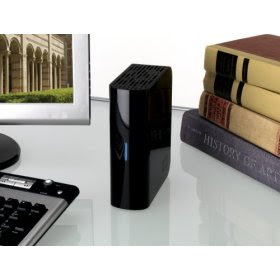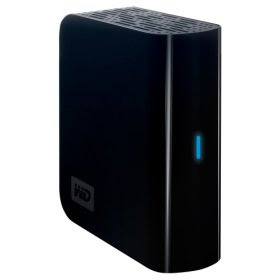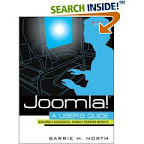Product Description
Are you running out of hard drive capacity? Do you need to archive some important digital documents, photos, or music? This elegant external hard drive, reminiscent of a book, is the perfect solution. It takes no more space than a paperback book. Collect two or more and they nest neatly together like volumes on a shelf.cent of a book, is the perfect solution. It takes no more space than a paperback book. Collect two or more and they nest neatly together like volumes on a shelf.
Product Features
The Essential series is the value line from Western Digital's external hard drive product line. Featuring a USB-only connection, the drive is targeted to price-conscious users who need lots of extra storage space, but don't need multiple connectivity options (USB, eSATA, Firewire).
Slightly reduced in thickness from its predecessor, v2.0 is about the size of an epic paperback novel only a few inches deeper. It weighs in around two pounds.
Gone is the green lighted circle which used to represent the power switch on older v1.0 drives - v2.0 uses a blue-lighted vertical drive activity indicator which alternates on and off when the drive is being accessed.
But also gone is the power switch itself. The latest generation of external drives from a variety of manufacturers including Western Digital and Seagate are now omitting them as a cost-saving measure. The My Book powers up upon plugging in the power and/or the USB connector. The drive is configured to power down after 10 minutes of inactivity or sensing the computer has been turned off.
Another substantial change is also becoming common with external drive models - doing away with the standard USB cable and replacing it with a USB-mini. The included cable, around three feet in length, may be too short for some applications, and be prepared to have some longer USB mini connector cables on hand if you want to extend the reach. Seagate has gone the same way.
Setting the drive up takes well under five minutes, from removing the shrink wrap on the box to actually seeing the drive on your desktop. The box comes with a very brief manual, a power cord (with a horizontally aligned transformer which may or may not be a good thing depending on where you plug it in), a USB cable, and the unit itself, wrapped in a protective plastic sheet.
The drive is pre-formatted using the FAT system, which creates a single partition of 465 gigabytes. The FAT file system assures the drive will function on multiple platforms. The drive will prompt you to install some minor diagnostic software and some Google tools you likely already have considered - Google Toolbar, Picasa, and Google Desktop (which indexes your hard drive and uses the Google search engine to help you find files.) For the latter, consider Copernic Desktop Search 2, which is free and offers superior search performance and better tools.
Most Windows and XP users will want to reformat the drive to the NTFS file system, which will support those 4+ gigabyte files FAT will not. You can easily reformat the drive under XP by clicking your way through Control Panel ("->" means you should click on this option) -> Administrative Tools -> Computer Management -> Storage -> Disk Management. It takes at least an hour to complete the reformat, and be aware the tools included on the drive will be erased so consider backing them up somewhere else if you care about them.
V2.0's redesign features a very shiny, smooth surfaced external case. I fear it will readily show fingerprints and scratches, so be extra careful when handling it.
As with the earlier model, no internal fan is apparent and heat dissipation is absolutely critical to the longevity of any hard drive. Some manufacturers have skimped on this, such as Seagate with their FreeAgent series which has had a high failure rate, but v1.0 Western Digital My Book drives have also historically not fared well either. Consumers want these devices to be nearly silent, and the tradeoff is product design that omits what is often the single most important component to guarantee a longer drive life - a cooling fan.
Although both series of drives seemed to get equally warm to the touch (but not uncomfortably hot), the single most important concern I have about Western Digital's entire My Book product line is drive longevity and data integrity. The last version of this product had scores of complaints about drive failures, almost always resulting in partial or total loss of your data. Most seemed to either fail during the first week of use or right around the first anniversary of purchase.
Different hard drives, depending on design, can generate more or less heat. It's not possible to tell precisely what model hard drive is being used in v2.0 (and whether it's an upgrade in quality from the earlier model), but perhaps Western Digital will have noticed the relatively high number of drive failures from its earlier product line and has used a different model for v2.0. Time will tell.
Both versions of the My Book series seem to offer adequate ventilation on the top, back, and bottom of the unit. Airflow will be very important to allow the heat from the hard drive to dissipate. In any external case without a fan to move air through the unit, or a heat sink to collect and bleed off the heat from the drive, the temperature inside the case will easily exceed 120 degrees, if not much higher if you reduce or block any of the ventilation holes. The higher the temperature, the sooner your drive will fail.
As with all USB external drives, the time spent transferring files back and forth will be much longer than experienced using an internal hard drive. The My Book series is best suited as a backup method to store copies of your important data in case one of your primary hard drives should fail. When powered down (which happens when the drive has not been accessed for around ten minutes), there will be an additional delay when attempting to access files from it, because the drive will need to spin-up (allow around 5-10 seconds for this).
As to the product's quality and longevity, as this is a new product line there is no easy way to guarantee whether this will prove a completely reliable product. But historically, external drives of all kinds tend to live shorter lives than internal drives, and Western Digital's warranty for this model remains one year. For $25 you can extend the warranty for two additional years from Western Digital's website.
But remember, it doesn't matter how long the warranty lasts if your data is gone because of a drive failure. No warranty will cover the costs to recover data from a failed drive (which can easily exceed $1000 with no guarantee of success). Do not rely on any hard drive to protect your most precious files alone. Every hard drive fails eventually. Instead, consider using the My Book Essential as a hard drive backup of your primary drives. Or if you need to rely on an external drive for day to day use, consider purchasing a second unit and using that to backup the first in case catastrophe strikes.
You can also prolong the life of your drive yourself by keeping it cool. I have a small inexpensive desk fan set on low blowing across my stack of external drives which does a good job. I also keep papers off of the drive, away from the sun or any heat vents.
Also pay attention to the sound your drive makes - it can be an early indicator of imminent failure. A whining or grinding sound (like a power saw off in the distance) is a clear danger sign. Loud clicking sounds when the drive is accessing data should sound a red alert that your drive is about to die. And should you encounter "delayed write failures" or other errors increasing in frequency as the drive ages, you should begin planning its replacement. Unfortunately, sometimes drives suddenly fail with no warning, so please create a backup strategy today before you lose up to 465 gigabytes of your files tomorrow.
Let's keep our fingers crossed that Western Digital has corrected the flaws from the first version of this product line. It's too bad the power switch is gone and they've switched to the less common USB-mini connectors, but as long as it keeps my data safe and secure, I can live with the changes.
Are you running out of hard drive capacity? Do you need to archive some important digital documents, photos, or music? This elegant external hard drive, reminiscent of a book, is the perfect solution. It takes no more space than a paperback book. Collect two or more and they nest neatly together like volumes on a shelf.cent of a book, is the perfect solution. It takes no more space than a paperback book. Collect two or more and they nest neatly together like volumes on a shelf.
Product Features
- Includes - External hard drive, USB cable, AC adapter and Quick Install Guide
- Smart and energy efficient - Turns itself on and off with your computer
- Saving and organizing your digital photo collection
- USB 2.0 Serial Bus Transfer Rate - 480 Mbits/s
- System Requirements - Available USB port, Windows 2000, XP, Vista, Mac OS X 10.4.8 or later
- Capacity (GB): 500
- Interface: USB 2.0
- Spindle Speed (RPM): 7200
- Buffer Memory: 16MB
- Average Seek (msec): <8.9
- Track-to-Track Seek Time (typical read, ms): 2.0
- Data Transfer Rate on USB 2.0: Up to 480 Mb/sec
- Temperature, Operating (°C): 5 to 35
- Temperature, Nonoperating (°C): -40 to 65
The Essential series is the value line from Western Digital's external hard drive product line. Featuring a USB-only connection, the drive is targeted to price-conscious users who need lots of extra storage space, but don't need multiple connectivity options (USB, eSATA, Firewire).
Slightly reduced in thickness from its predecessor, v2.0 is about the size of an epic paperback novel only a few inches deeper. It weighs in around two pounds.
Gone is the green lighted circle which used to represent the power switch on older v1.0 drives - v2.0 uses a blue-lighted vertical drive activity indicator which alternates on and off when the drive is being accessed.
But also gone is the power switch itself. The latest generation of external drives from a variety of manufacturers including Western Digital and Seagate are now omitting them as a cost-saving measure. The My Book powers up upon plugging in the power and/or the USB connector. The drive is configured to power down after 10 minutes of inactivity or sensing the computer has been turned off.
Another substantial change is also becoming common with external drive models - doing away with the standard USB cable and replacing it with a USB-mini. The included cable, around three feet in length, may be too short for some applications, and be prepared to have some longer USB mini connector cables on hand if you want to extend the reach. Seagate has gone the same way.
Setting the drive up takes well under five minutes, from removing the shrink wrap on the box to actually seeing the drive on your desktop. The box comes with a very brief manual, a power cord (with a horizontally aligned transformer which may or may not be a good thing depending on where you plug it in), a USB cable, and the unit itself, wrapped in a protective plastic sheet.
The drive is pre-formatted using the FAT system, which creates a single partition of 465 gigabytes. The FAT file system assures the drive will function on multiple platforms. The drive will prompt you to install some minor diagnostic software and some Google tools you likely already have considered - Google Toolbar, Picasa, and Google Desktop (which indexes your hard drive and uses the Google search engine to help you find files.) For the latter, consider Copernic Desktop Search 2, which is free and offers superior search performance and better tools.
Most Windows and XP users will want to reformat the drive to the NTFS file system, which will support those 4+ gigabyte files FAT will not. You can easily reformat the drive under XP by clicking your way through Control Panel ("->" means you should click on this option) -> Administrative Tools -> Computer Management -> Storage -> Disk Management. It takes at least an hour to complete the reformat, and be aware the tools included on the drive will be erased so consider backing them up somewhere else if you care about them.
V2.0's redesign features a very shiny, smooth surfaced external case. I fear it will readily show fingerprints and scratches, so be extra careful when handling it.
As with the earlier model, no internal fan is apparent and heat dissipation is absolutely critical to the longevity of any hard drive. Some manufacturers have skimped on this, such as Seagate with their FreeAgent series which has had a high failure rate, but v1.0 Western Digital My Book drives have also historically not fared well either. Consumers want these devices to be nearly silent, and the tradeoff is product design that omits what is often the single most important component to guarantee a longer drive life - a cooling fan.
Although both series of drives seemed to get equally warm to the touch (but not uncomfortably hot), the single most important concern I have about Western Digital's entire My Book product line is drive longevity and data integrity. The last version of this product had scores of complaints about drive failures, almost always resulting in partial or total loss of your data. Most seemed to either fail during the first week of use or right around the first anniversary of purchase.
Different hard drives, depending on design, can generate more or less heat. It's not possible to tell precisely what model hard drive is being used in v2.0 (and whether it's an upgrade in quality from the earlier model), but perhaps Western Digital will have noticed the relatively high number of drive failures from its earlier product line and has used a different model for v2.0. Time will tell.
Both versions of the My Book series seem to offer adequate ventilation on the top, back, and bottom of the unit. Airflow will be very important to allow the heat from the hard drive to dissipate. In any external case without a fan to move air through the unit, or a heat sink to collect and bleed off the heat from the drive, the temperature inside the case will easily exceed 120 degrees, if not much higher if you reduce or block any of the ventilation holes. The higher the temperature, the sooner your drive will fail.
As with all USB external drives, the time spent transferring files back and forth will be much longer than experienced using an internal hard drive. The My Book series is best suited as a backup method to store copies of your important data in case one of your primary hard drives should fail. When powered down (which happens when the drive has not been accessed for around ten minutes), there will be an additional delay when attempting to access files from it, because the drive will need to spin-up (allow around 5-10 seconds for this).
As to the product's quality and longevity, as this is a new product line there is no easy way to guarantee whether this will prove a completely reliable product. But historically, external drives of all kinds tend to live shorter lives than internal drives, and Western Digital's warranty for this model remains one year. For $25 you can extend the warranty for two additional years from Western Digital's website.
But remember, it doesn't matter how long the warranty lasts if your data is gone because of a drive failure. No warranty will cover the costs to recover data from a failed drive (which can easily exceed $1000 with no guarantee of success). Do not rely on any hard drive to protect your most precious files alone. Every hard drive fails eventually. Instead, consider using the My Book Essential as a hard drive backup of your primary drives. Or if you need to rely on an external drive for day to day use, consider purchasing a second unit and using that to backup the first in case catastrophe strikes.
You can also prolong the life of your drive yourself by keeping it cool. I have a small inexpensive desk fan set on low blowing across my stack of external drives which does a good job. I also keep papers off of the drive, away from the sun or any heat vents.
Also pay attention to the sound your drive makes - it can be an early indicator of imminent failure. A whining or grinding sound (like a power saw off in the distance) is a clear danger sign. Loud clicking sounds when the drive is accessing data should sound a red alert that your drive is about to die. And should you encounter "delayed write failures" or other errors increasing in frequency as the drive ages, you should begin planning its replacement. Unfortunately, sometimes drives suddenly fail with no warning, so please create a backup strategy today before you lose up to 465 gigabytes of your files tomorrow.
Let's keep our fingers crossed that Western Digital has corrected the flaws from the first version of this product line. It's too bad the power switch is gone and they've switched to the less common USB-mini connectors, but as long as it keeps my data safe and secure, I can live with the changes.






















0 comments:
Post a Comment